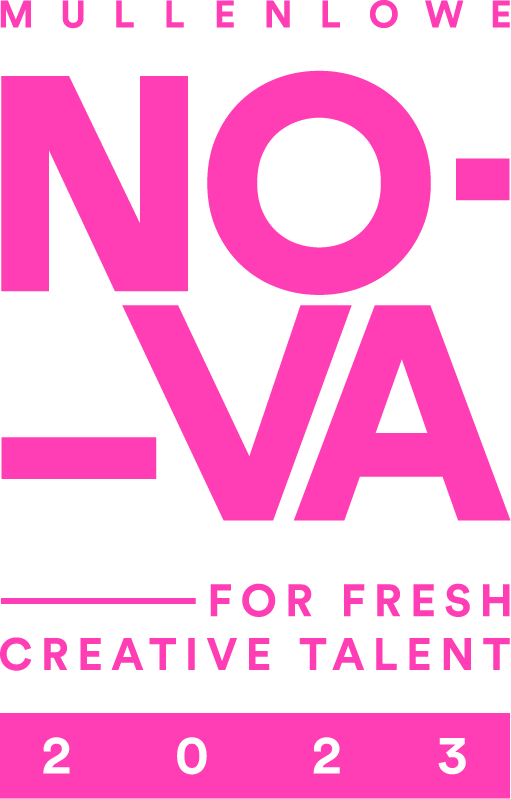Raising The Bar In A Creative Setting

Have you heard about the MullenLowe NOVA Awards? GLITCH takes on a new venture and interviews judge, Hannah Hayes-Westall from the MullenLowe NOVA Awards judge panel. Discussing “raising the bar” in a creative setting, what it means to win a MullenLowe NOVA Award and other important topics.
ABOUT THE AWARD
What impact does the MullenLowe NOVA award have on students graduating with an art degree?
Obviously I can’t speak for the winners themselves, but my observations of the careers and output of winners of previous awards has been that the increased visibility, coupled with the perhaps unexpected financial support, allows them a little bit of breathing space to develop their practice further after leaving college. Time and space to create and develop are considered luxuries in this strange 2020 environment (unhelpfully in my opinion) particularly, so any initiatives that can help to provide them in a fairly democratic way are to my mind, hugely powerful tools.
What potential does the Award serve as a driving factor/motivator for “raising the bar” in term of graduate’s creativity and quality work?
The credit for raising the creative bar really must sit with the creativity, ingenuity and excellence of the teaching staff and students at Central Saint Martins. We’ve seen that even in this incredibly difficult academic cycle, with its sudden switch to remote working, the college, students, and everyone involved has maintained its world leading reputation. On a personal level, being part of this year’s judging process was very satisfying for me as I see the MullenLowe NOVA Awards as a way of focusing the attention of the creative community onto some of the most outstanding talents emerging into industry.
What is the selection criteria based on? What is the MullenLowe NOVA Award looking for? From this year’s line up, what were the key trends identified?
The criteria are consistent year on year, focused on creative thought, ideation, execution, and the effectiveness of the resolve. This year of course the great difference was that everything was appraised online rather than in a gallery setting, meaning that students had to deploy a range of techniques to communicate their concepts.

Narrative COVID-19 from Wuhan to London by Liang Xiao
There were of course many pieces that focused on the pandemic and infection but what felt interesting was that none explored these in isolation. One of the shortlisted candidates, Liang Xiao, explored ideas around contagion and cleanliness in the context of xenophobia and anti-Asian sentiment, whilst another, Jo Harrison-Hall explored the tropes of handwashing and the feelings of security, however the most dominant theme to emerge was that of identity.

Rinse and Repeat by Jo Harrison-Hall
Against a global backdrop of social justice protests, the focus on identity reflects the concerns that are dominating society and it wasn’t a surprise to see this. However what was wonderful to me was the way in which the students deployed such a lot of ways into ideas around representation, even if identity was not the focus of their project.

Representation by Jahnavi Inniss from the Unilever #unstereotype Award winner
The excellent project, Representation, from the Unilever #Unstereotype Award winner Jahnavi Inniss dealt directly with the lack of representation of Black people in British history through work that was not only engaging but created a set of tools that schools and the general public could engage with and deploy directly.
By contrast, Ines Duplessis, an Industrial Design MA, was shortlisted for an incredibly absorbing project Aneo, the future is inside you, which created new ways of thinking about the value of menstrual blood in order to effect a change in social construals of the value of people who have periods.

ANEO by Ines Duplessis
Considering the challenges to the industry and prospects for graduates as a result of the current climate. Would you say creative students have successfully adapted to the creative constraints of lockdown measures and integrated digital alternatives to their work? If so, what has been the most prominent digital alternative used?
That’s a great question. The way that technology featured in some of the submissions was extraordinary, but I think what was clear was that the strongest projects that were presented in the traditional format were also surfaced and many, such as the BA Fashion Comms student Joseph Bates with his project Lokko, and the M ARCH Architecture student Kleanthis Kyriakou’s project House of Extravaganza really captured a unique creative resolve to the challenge they had set themselves, without any loss of effectiveness.

Lokko by Joseph Bates

House of Extravaganza by Kleanthis Kyriakou
The current pandemic has shook the fashion industry in many ways, encouraging a shift to re-define our priorities and advance our commitments to sustainability and technology innovation.
What is your view on the opportunities currently available for recent graduates to overcome the overshadowing of the industry’s biggest names? and how important is design innovation in helping propel them forward?
The fashion industry is hardly alone in suffering from the huge changes that the pandemic has wrought in such a short space of time, but data shows that the fashion and apparel industry has been hit harder than almost any industry aside from travel and hospitality. There is no way that this level of contraction will not affect the opportunities available for today’s fashion graduates as the traditional routes into established fashion businesses seem likely to simply disappear, at least in the short term.
However, whilst established businesses have suffered and continue to do so, there has been a simultaneous explosion of new fashion businesses trading directly with their end customer, finding them through social, and working with local producers to create smaller runs of products. Within this new paradigm, the focus on sustainable and technologically innovative products has already shown commercial advantages, so for me, I think the opportunities for fashion grads focusing on these areas are not quite as dark as they might seem from looking at the wider industry.
Our mission, at GLITCH is to establish a platform that promotes the work of new talent & design innovation to help emerging creatives build a bridge between their aspirations and recognition from the industry. It also serves as a collaboration platform to connect creatives across disciplines to access resources they may need to create and deliver their creative vision.
In your experience, are there sufficient opportunities available that support emerging creatives in establishing that recognition? What role do awards such as the MullenLowe NOVA Awards play in this and what alternatives are available to those not receiving awards.
It’s really fantastic that you are so committed to creating a platform to amplify emerging creative voices. Mark (Hayes-Westall, my husband and co-publisher of FADmagazine) first conceived FADmagazine as a way to remove the barriers of language and access between contemporary artists, particularly emerging artists, and a wider audience (and a way to hang out with fun people at private views of course!). We’ve found it super rewarding to see how we can play a small role in helping new voices find new listeners.
Awards like the MullenLowe NOVA Awards are part of an ecosystem of support in the UK and globally that I think create more amplification. Where creatives aren’t selected I think it’s always helpful to reach out to publications they admire and let them know about new projects. At FADmagazine we are often approached via Instagram, to the extent that we are now regularly handing the @worldoffad account over to curators to hold exhibitions using our platform. REFLECTIONS was a show that ran from 21-22 September curated by @maddie.rose.hills. The show featured sixteen works created between March – August 2020, submitted by artists across the world through an Open Call.
Another challenge faced by recent graduates is the culture of unpaid internships with high expectations from employers on work experience and skills, which excludes students who may not have the resources to work for free or the connections to fast- track into the industry.
How can the industry change this? and what can be expected/encouraged for organisations in the fashion industry to capitalise on the talent available and establish an inclusive pool of opportunities to all emerging creatives?
The fashion industry is famously built from the blood, sweat and tears of its many often-unpaid interns, and I agree absolutely that it damages the industry as a whole if it is both the only way into the industry and only available to those who can afford to be part of it.
What’s so encouraging is that we have a developing trading environment where the audience for fashion particularly is moving to a majority of mostly quite young people, who act on their beliefs about the world, which creates a commercial imperative for change. A recent Deloitte study showed that income inequality is the second most important concern for millennials after climate change, and ahead of diversity for Gen Z. Two-thirds of millennials believe that, because of their backgrounds some people never get a fair chance to achieve success no matter how hard they study and work. They also believe that whilst Government is primarily responsible for addressing this, business should be playing a large role, and its this that I think means we’re going to see some real change as companies realise that they won’t be able to get away with maintaining poor hiring policies without commercial repercussions.
What is one piece of advice you would give to a creative graduate?
I have definitely said this before, but the absolute most important thing you can do as a creative grad is to keep up your practise. If college helps you establish your creative skills and unlock new ways of thinking, the period after is often where you see people really develop their own creative voice and take it to the next level. Coupled with that, the importance of maintaining some of the networks of people you connect with through college can’t be understated. The creative world thrives on feedback, and I have seen that for creatives who build a community of voices to listen to and talk to about their work, the work benefits hugely, (and of course it gives you fun people to go to shows with).
Lastly when it comes to sustainability, what do you see as the biggest transformation that will take place in the future of fashion?
My great hope is that the idea of wear-once fast fashion becomes socially unacceptable. Regardless of the recyclability of the materials used, the energy and the human costs of this kind of product are so enormous that I would like to see a reframing of the conversation around creativity and utility instead of simply around consumption. A sustainability expert I know articulated the problem of working in sustainable fashion as that there is no such thing as sustainable fashion. We are, by definition, creating products and persuading people they want them, and I think we need to understand that since this isn’t going to change we need to deploy all the desire creation skills we have as an industry, alongside all the technology and creativity we can get our hands on to minimise our impact.
Hannah Hayes-Westall is a writer and strategist, Co-Publisher of contemporary art titles fadmagazine.co.uk and the no-news newspaper Art of Conversation and Strategy Director at MullenLowe London.
This article was originally published on GLITCH Magazine








